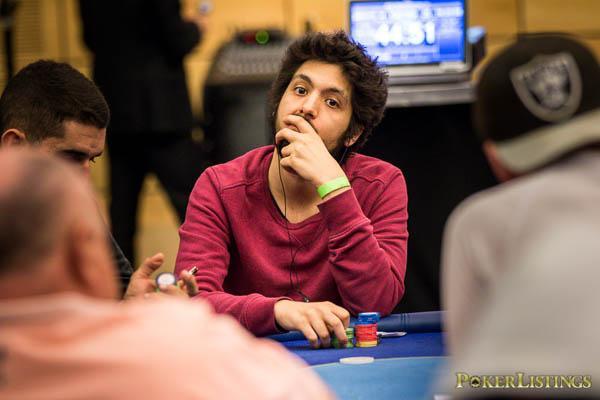What to Do When You’re Not in a Poker Hand
Don’t lose focus when you’re not in a poker hand! Use these five top tips to raise your edge when you fold.
-
T&Cs Apply | Play Responsibly | GambleAware
18+ | Play Responsibly | T&C Apply
-
T&Cs Apply | Play Responsibly | GambleAware
T&Cs Apply | Play Responsibly | GambleAware
- Fact Checked by: PokerListings
- Last updated on: July 23, 2025 · 7 minutes to read
Ask anyone what you should do when you play live and they’ll often say that tight is right. Because players are looser in the live arena than they are when they play poker online, you can get ahead of the curve simply by playing fewer hands. However, for all the things you can do when you’ve got some cards in front of you, there are just as many things you can do to raise your edge when you fold.
Put simply, it’s possible to improve your potential in a live game by learning what to do when you’re not in a poker hand. From maintaining your focus and learning how to count chips to getting reads, you can do yourself a lot of good by making use of your downtime. This guide will help you master the art of playing poker when you’re not in a hand – especially if you’re used to playing in online poker rooms. So, if you’re ready to do something when you’ve got nothing, let’s get started.

- Pay Attention
The easiest thing to do when you’re not in a poker hand is lose focus. It’s easy to play multiple games online or watch a video while you’re grinding because HUDs help you keep track of the action. You don’t have that luxury in the live arena. No one is going to tell you what happened in the previous hand if you weren’t paying attention. They might give you a brief recap but it won’t be a detailed report.
If you want to know exactly what’s going on, you need to remain focused, even when you’re not in a hand. That doesn’t mean you have to have your eyes glued to the pot for hours on end. However, you do need to have at least one eye on the action. If you spend all of your time wandering around the poker room or looking at your phone, you’re going to miss a lot of valuable information. As the famous Bruce Lee once said: “It’s like a finger pointing away to the moon. Don’t concentrate on the finger or you will miss all that heavenly glory.”
- Develop Your Own HUD
Using a heads-up display (HUD) has become standard practice when you play online. Unfortunately, you won’t have this luxury when you play live. However, that doesn’t mean you can’t develop your own internal HUD. You can use the in-between poker hands to track three key stats:
- How often someone plays a hand (VPIP)
- How often someone raises pre-flop (PFR)
- How aggressive they are on the flop, turn, and river (AF)
A good way to assign values to each of these traits is to watch a single player for 20 hands. During those hands, count how many times they call and fold pre-flop. Also count how often they raise and re-raise pre-flop, as well as how many times they bet post-flop. If it helps, note things down on a piece of paper.
Once you’ve observed 20 hands, divide the number of times they did something by 20. For example, if the player called five times in 20 hands, their VPIP is 25% (5 / 20 = 0.25 X 100). We know that 20 isn’t a very large sample size. However, you see far fewer hands in a live game than you do online. Therefore, we’re just trying to get a rough idea of someone’s stats, which is why we don’t need a huge sample size.
Moreover, the calculations don’t have to be exact. If we know someone has an approximate VPIP of 25%, we can say they’re fairly loose. It might not be totally accurate but it’s close enough and gives us a foundation to build on. Carrying out this type of analysis in between poker hands isn’t easy but it’s worth practicing. The more you do it, the easier it will be and, in turn, the better reads you’ll get on your opponents.
- Track Players, Hands, and Ranges
There are three things you should always be thinking about when you’re not in a hand: players, hands, and ranges. To help you focus on these three things, you can ask these questions:
- Who’s making the most moves and who’s playing tight?
- Which hands do people play in small, medium, and large pots?
- Which hands appear after a value bet and bluff?
This information is useful in isolation but the real reason you’re getting answers to these questions is so you can start thinking about ranges. For example, if you’ve seen an active player show J-T suited in a three-bet pot and table a bluff with 5-6 offsuit, you can assume they have a wide range.
Yes, ranges will vary from hand to hand. However, if you can put players into categories, it will make your life a lot easier. So, if you label someone as a “wide range” player, you should be more inclined to think they have a lot more potential hands than a “tight range” player.
Of course, there are other factors to consider. However, people rarely stray too far from their natural tendencies. Therefore, if you can track players and their hands, you can get a better handle on their potential ranges. And one of the best times to gather this information is when you fold.
- Get Social
Poker is all about making decisions with imperfect information. Therefore, the more data you can collect, the easier it is to make decisions. Being sociable and chatting with players is a great way to learn more about them and, in turn, pick up on their strengths and weaknesses. Indeed, this is one of the tricks old-school players such as Phil Hellmuth and Doyle Brunson use to get reads on their opponents.
Players who cut their teeth online are great when it comes to math and game theory. However, live poker is a social game and you can get a real advantage by getting a handle on someone’s personality. Talking to people will help you understand if they’re a novice playing for fun or a serious grinder. A quick chat might also tell you if someone is on tilt, happy, or drunk.
Being sociable also creates a positive table image. Sitting in silence when you’re not playing a hand could give off the wrong vibes. If people think you’re being distant or ignorant, they may decide to go after you. Therefore, if you can put across a friendly persona, people might not want to take your money. That, in turn, means you can probably get away with more bluffs.
- Practice Counting
No one wants to stand out when they play live poker and not being able to count out a bet is a dead giveaway that you’re a newbie. Even if it’s your first live game, don’t let people see you’re struggling to count. The time in between hands gives you a great opportunity to improve your counting skills.
Look at how many chips someone puts into the middle and try to work out the size of their bet before the dealer announces it. At the same time you’re doing that, keep track of all the money that’s been put into the pot and keep a running count. The better you can get at eye-balling stacks of chips and mental arithmetic, the more you can look like a pro.
Something else you can do while you’re learning to count is casually handle your own chips. Learning to rifle chips is good but it’s better to get comfortable with cutting your stack and counting out bets. Don’t make it obvious but use the time in between poker hands to get real control over your chips and make your cuts as slick as possible.

Make Sure You’re Always Thinking
Those are five great ways to improve your potential in a live game. Of course, if you don’t fancy a trip to your local casino, you can ante-up online with ease. Our recommended real money poker sites not only give you access to hundreds of cash games and tournaments but lucrative bonuses.
Whichever way you decide to play, there’s always value in remaining focused and picking up reads when you’re not in a hand. So, regardless of whether you’re grinding online or in the live arena, remember that what you do outside of a hand is just as important as what you do during a hand.
-
Stake.US Poker4.3
- Rakeback 5%
- $55 Stake Cash + 260K Gold Coins
T&Cs Apply | Play Responsibly | GambleAware
18+ | Play Responsibly | T&C Apply
-
Appeak Poker4.1
- 1,000 Chips Daily
- FREE 5,000 Chips
T&Cs Apply | Play Responsibly | GambleAware
T&Cs Apply | Play Responsibly | GambleAware
-
- 2,500 Gold Coins + 0.50 Sweeps Coins
T&Cs Apply | Play Responsibly | GambleAware
18+ | Play Responsibly | T&C Apply
-
WSOP.com4.3
- Up to 70%
- 100% up to $1000
T&Cs Apply | Play Responsibly | GambleAware
T&Cs Apply | Play Responsibly | GambleAware
-
CoinPoker4.1
- 33% Weekly
- 150% up to 2000$
T&Cs Apply | Play Responsibly | GambleAware
+18 / T & C apply / Play responsible
